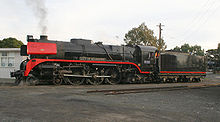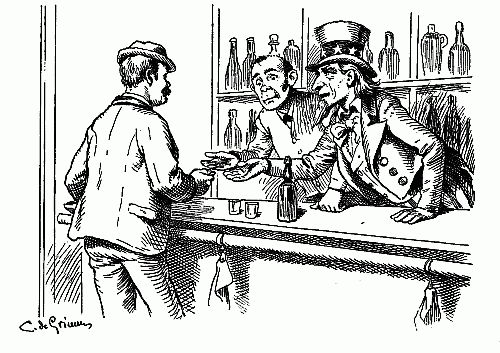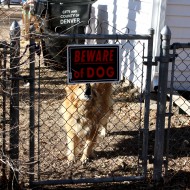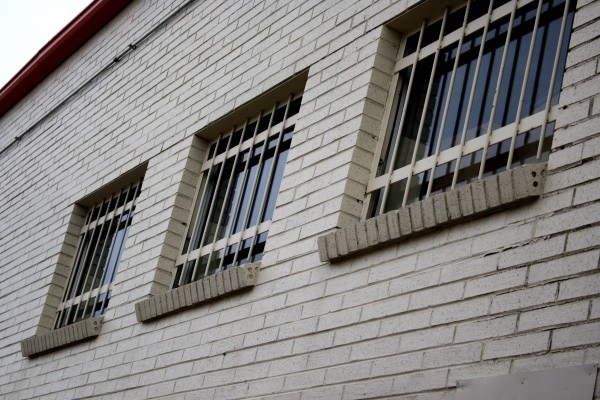| Victorian Railways R class | |
|---|---|

Victorian Railways publicity photograph of R 701, 1951
|
|
| Specifications | |
| Power type | steam |
| Builder | North British Locomotive Company, Glasgow |
| Configuration | 4-6-4 |
| Gauge | 5 ft 3 in (1,600 mm) Irish gauge |
| Driver diameter | 73 in (1,854 mm) |
| Length | 77 ft 3 1⁄4 in (23.55 m) |
| Axle load | 19 tons 10 cwt (43,700 lb or 19.8 t) |
| Weight on drivers | 50 tons 10 cwt (113,100 lb or 51.3 t) |
| Locomotive weight | 107 tons 12 cwt (241,000 lb or 109.3 t) |
| Tender weight | 79 tons 16 cwt (178,800 lb or 81.1 t) |
| Locomotive and tender combined weight |
187 tons 8 cwt (419,800 lb or 190.4 t) |
| Tender capacity | 6 tons 0 cwt (13,400 lb or 6.1 t) coal 9,000 imp gal (40,915 L; 10,809 US gal) water |
| Boiler pressure | 210 psi (1.45 MPa) |
| Firegrate area | 42 sq ft (3.9 m2) |
| Heating surface: – Total |
2,705 sq ft (251.3 m2) |
| Cylinders | 2 |
| Cylinder size | 21.5 in × 28 in (546 mm × 711 mm) |
| Tractive effort | 32,080 lbf (142.7 kN) at 85% boiler pressure |
| Career | |
| Number in class | 70 |
Orders eventually totalling 70 locomotives were placed with the North British Locomotive Company of Glasgow. Once initial teething problems were overcome, R class locomotives proved to be a success and their power and speed enabled faster timetabled services. However, they were almost immediately superseded by mainline diesel-electric and electric locomotives on the VR from 1952 onwards. With successive orders of diesel-electric locomotives through the 1950s and 1960s gradually displacing them, all but seven of the class were withdrawn and cut up for scrap.
Four of the remaining locomotives were later restored to operating condition between 1984 and 1998. These have seen use ranging from hauling special heritage train services through to substituting for modern diesel-electric locomotives on regular intercity rail services run by V/Line and West Coast Railway. Another surviving example, number R 704, was originally displayed at the Festival of Britain in 1951 and is now on permanent display at the Australian Railway Historical Society museum in North Williamstown, Victoria.
HistoryEdit
Within a few years of the introduction of the A2 class 4-6-0 in 1907,
it was clear that increasingly heavy train loads would require a more
powerful locomotive on principal main lines. From as early as 1918, a
series of drawings for potential 4-6-2
'Pacific' type locomotives began to emerge from the VR's Locomotive
Design Section, some of which were ultimately developed into the 3
cylinder S class heavy Pacific of 1928.[1]
However, plans for a smaller 2 cylinder Pacific, with an axle load
below 20 tons to allow operation across the VR mainline network, were
put on hold during the 1930s. This was partly due to the decline in
traffic and revenue due to the Great Depression, and partly due to the improved power outputs and efficiency from the A2 locomotives after the application of a series of smokebox design and draughting changes referred to as 'Modified Front End' in the mid-1930s.
By 1943 however, the situation had changed. There was a massive increase in traffic brought by the advent of World War II, and the A2s were by this point well past their prime. The VR Locomotive Design Section once again turned their attention to the proposed Pacific replacement. The addition of a mechanical stoker, the enlarging of the grate from 37 to 42 square feet (3.4 to 3.9 m2) for increased performance and the use of heavy bar-frame construction for increased durability significantly increased the projected weight of the locomotive. To keep the axle load to 19.5 tons, the design by 1944 had changed from a 4-6-2 'Pacific' to a 4-6-4 'Hudson' wheel arrangement.[2]
The R class reflected an ongoing evolution of VR locomotive design
and a response to the changing operational environment of the VR in the
postwar era.
The R class adopted the bar frame construction of the H and S class express passenger locomotives, which had proven to be far more robust in coping with the VR's varying track quality than the fracture-prone plate frames of the A2.
The decision to install MB Type 1 mechanical stoker equipment (capable of feeding up to 10,000 lb (4,536 kg) of coal per hour)[3] on a locomotive with only a 42-square-foot (3.9 m2) grate reflected improved postwar working conditions for locomotive firemen, the varying quality of postwar coal and the expectation of sustained high speed operation of the locomotive. The manually fired prewar VR S class Pacific, although capable of 2,300 drawbar horsepower (1,700 kW), was limited by the physical ability of the fireman to feed its 50-square-foot (4.6 m2) grate and as such was reliant on coal with a high calorific value.[4]
Online locomotive database steamlocomotive.com notes: "They showed an interesting blend of European, British, American, and Australian practice. The slotted pilot is Australian, the long sand dome American, the Belpaire firebox and cab British, and the mid-line smoke lifters ('elephant ears') European."[5]
Other modern features included SKF roller bearings on all axles and the innovative, lightweight SCOA-P type driving wheels, which were specially developed for the R class by the Steel Company of Australia.[6]
By the late 1940s, the A2 class was at the end of its life, and new motive power was desperately required. Australian Federal Government restrictions on the availability of US dollars (designed to favour trade within the British Empire) precluded the VR from purchasing American diesel-electric locomotives.[8] The VR broke with a long standing policy of in-house steam locomotive construction and called for tenders to construct an additional 50 R class. The contract was awarded to North British Locomotive Company in Glasgow, Scotland on 21 September 1949. The order was increased to 70 on 12 January 1950 with the cancellation of the original order of 20 locomotives from VR's Newport shops. Parts manufactured for the Newport order were used to complete the NBL-built locomotives.
Further delays were experienced once the locomotives finally arrived from May 1951 onwards. Corrosion had already set in during their sea voyage as deck cargo from Scotland to Australia, and there were numerous manufacturing defects requiring rectification. R 703 was the first of the class in service, on 27 June 1951, and the last of the fleet R 769 did not enter service until 23 September 1953.[7]

Once the manufacturing defects and corrosion damage were corrected,
the R class proved to be a fine locomotive in its intended role of
express passenger service. Dynamometer car testing showed they were
capable of producing a maximum 1840 drawbar horsepower (1,372 kW) at 37.5 mph (60.4 km/h),[10] a significant improvement over the A2's 1,230 hp (920 kW) at 32 mph (51 km/h).[11]
They quickly took over virtually all mainline passenger services
previously operated by the A2 and passenger timetables were revised to
take advantage of their higher performance, with cuts to journey times
as high as 60 minutes.[12] Individual R class locomotives were soon running upwards of 950 to 1,250 miles (1,530 to 2,010 km) each per week.[13]
Their mechanical stoker, smooth riding characteristics and large, comfortable cab also made them popular with crews.
The R's impressive debut was cut short by the introduction of the B class (EMD ML2) diesel electric locomotives from July 1952, a locomotive type based on the latest GM EMD designs and built in Australia under licence by Clyde Engineering. By the end of 1953, the success of the B class saw the R class withdrawn from The Overland service to Adelaide and also VR's passenger service to Mildura. The Gippsland line, which was electrified to Traralgon by 1955, was the first line to see the complete withdrawal of the R class from service. On 18 May 1964, R 703 worked the last regular steam-hauled passenger train out of Melbourne, the 6.05pm Geelong service.[14]
The Rs were pressed into secondary passenger and goods service, roles which for which a Hudson with large diameter driving wheels was sometimes a less than ideal choice. There was little opportunity to exploit their high speed capability. Furthermore, their relatively low factor of adhesion (4.08) and lack of fully compensated springing, coupled with the tendency of locomotives to transfer weight to the rearmost wheels under high drawbar pull conditions (which in the case of the R meant a weight transfer from the driving wheels to the unpowered trailing truck) caused them to slip when starting heavy goods trains.[15]
The R class is remembered by many for its role as power for the seasonal grain harvest. In times of a good harvest, virtually every available locomotive would be marshalled into service to shift wheat trains of over 1,000 tons from Victoria's Western district through to the ports for export. Double-headed R class locomotives, sometimes aided by a third R acting as banking engine at the rear, could be seen battling the 3 mile, 1 in 52 (1.92%) Warrenheip Bank out of Ballarat.
In the 1960s, as the railway preservation movement began to gather momentum, a small number of R class locomotives found a new role as power for excursion train services. In this role they were able to fulfill their intended role of high speed passenger travel, with speeds of over 80 mph (129 km/h) being recorded.[16]
R 707, which due to various defects had still not been put into
service by 1954, was selected for modification for pulverised brown coal
(PBC) operation, in conjunction with trials of this fuel being
undertaken with X class 'Mikado'
X 32. While the PBC locomotives performed well, the expense of
installing storage and handling facilities became increasingly
uneconomic with falling prices for fuel oil and the success of
diesel-electric traction. The conversion had also reduced the water
capacity of R 707's tender such that there was insufficient margin for
delays or bad weather running on many routes, confining the locomotive
to the shorter Melbourne - Geelong and Melbourne - Seymour lines.[17] The experiments were discontinued and R 707 was converted back to black coal operation in 1957.[18]
R 719 and 748 were converted to oil-firing during the mid-1950s.[19] They performed very well and were favourites among crews for their clean, cinder-free running.[17] The reduced maintenance associated with their oil-fired operation meant they also had the highest availability of any of the R class and as such recorded the highest mileages of any of the class.[20] However, rising fuel oil costs and the ongoing dieselisation program on the VR precluded any further locomotives from being converted.
As the VR focussed its attention on diesel electric traction, steam locomotive depots were gradually closed down and the remaining steam fleet became a much lower maintenance priority. A particular problem was the lack of feedwater treatment, which saw many R class locomotive boilers condemned for severe corrosion well before the end of their design life.[7]
1967 marked the final year of the R class in general service with the withdrawal of the final three operating in this capacity: R 742 on 23 June, R 735 on 24 July and oil-burning R 748 on 10 August 1967. After this date, the remaining R class locomotives on the register were used for special enthusiast workings. R 706, R 769 and R 749 continued in this role until boiler and mechanical conditions made them too costly to maintain and they too were withdrawn, leaving only R 707 and R 761 in operable condition.[7]
Scrappings had commenced with R 755 in 1960, which had been involved in a serious rear-end collision with a freight train earlier that year, and continued through the decade. By 1970, only seven of the class remained intact. R 707 and R 761 continued to haul various special trains until both were withdrawn in 1974 as their boiler certificates expired, and with their withdrawal came the end of over a century of mainline steam locomotive operation on Victorian Railways.

R class locomotives saw a relatively brief but notable return to
operation of regularly scheduled mainline passenger rail services when
in the late 1990s, two of the remaining locomotives were extensively
modified and returned to service. Private rail operator West Coast Railway, which had successfully tendered for operation of the Warrnambool railway line
in the privatisation of the Victorian passenger rail network, modified
the locomotives as part of an ambitious plan to operate steam-powered
express passenger services running to the same timetable as those
operated by modern diesel electric locomotives.[21]
In order to ensure the locomotive's ability to reliably keep to the timetable, a number of notable design changes were made. These included the replacement of the original single blastpipe with dual Lempor ejectors, conversion to oil firing, fitting of power reverse, and the addition of a diesel control stand to allow for multiple unit operation with diesel electric locomotives where required.[22] R 711 entered service on regular trains on 21 November 1998,[23] and design refinements based on its performance in service were made to the subsequent conversion of R 766.[24]
For a number of years, the modified R class locomotives could be seen in regular operation between Melbourne and Warrnambool, keeping a fast 3 hour 13 minute schedule which included six stops along the 267 km (166 mi) route.[21] In 2004, West Coast Railway ceased operations after a number of operational problems made the business unviable.[25] The two R class locomotives made a final trip back to Newport Workshops, where they passed into the care of Steamrail Victoria.
By 1943 however, the situation had changed. There was a massive increase in traffic brought by the advent of World War II, and the A2s were by this point well past their prime. The VR Locomotive Design Section once again turned their attention to the proposed Pacific replacement. The addition of a mechanical stoker, the enlarging of the grate from 37 to 42 square feet (3.4 to 3.9 m2) for increased performance and the use of heavy bar-frame construction for increased durability significantly increased the projected weight of the locomotive. To keep the axle load to 19.5 tons, the design by 1944 had changed from a 4-6-2 'Pacific' to a 4-6-4 'Hudson' wheel arrangement.[2]
Design Features
The R class adopted the bar frame construction of the H and S class express passenger locomotives, which had proven to be far more robust in coping with the VR's varying track quality than the fracture-prone plate frames of the A2.
The decision to install MB Type 1 mechanical stoker equipment (capable of feeding up to 10,000 lb (4,536 kg) of coal per hour)[3] on a locomotive with only a 42-square-foot (3.9 m2) grate reflected improved postwar working conditions for locomotive firemen, the varying quality of postwar coal and the expectation of sustained high speed operation of the locomotive. The manually fired prewar VR S class Pacific, although capable of 2,300 drawbar horsepower (1,700 kW), was limited by the physical ability of the fireman to feed its 50-square-foot (4.6 m2) grate and as such was reliant on coal with a high calorific value.[4]
Online locomotive database steamlocomotive.com notes: "They showed an interesting blend of European, British, American, and Australian practice. The slotted pilot is Australian, the long sand dome American, the Belpaire firebox and cab British, and the mid-line smoke lifters ('elephant ears') European."[5]
Other modern features included SKF roller bearings on all axles and the innovative, lightweight SCOA-P type driving wheels, which were specially developed for the R class by the Steel Company of Australia.[6]
Production
An order for 20 locomotives was placed with the VR's Newport Workshops in 1946, but remained unfulfilled for years as shortages of steel and manpower saw other projects (such as the overhaul of badly run-down infrastructure and the building of extra X class goods locomotives) given precedence.[7]By the late 1940s, the A2 class was at the end of its life, and new motive power was desperately required. Australian Federal Government restrictions on the availability of US dollars (designed to favour trade within the British Empire) precluded the VR from purchasing American diesel-electric locomotives.[8] The VR broke with a long standing policy of in-house steam locomotive construction and called for tenders to construct an additional 50 R class. The contract was awarded to North British Locomotive Company in Glasgow, Scotland on 21 September 1949. The order was increased to 70 on 12 January 1950 with the cancellation of the original order of 20 locomotives from VR's Newport shops. Parts manufactured for the Newport order were used to complete the NBL-built locomotives.
Further delays were experienced once the locomotives finally arrived from May 1951 onwards. Corrosion had already set in during their sea voyage as deck cargo from Scotland to Australia, and there were numerous manufacturing defects requiring rectification. R 703 was the first of the class in service, on 27 June 1951, and the last of the fleet R 769 did not enter service until 23 September 1953.[7]
Service life

R 730, hauling a Melbourne-Dimboola passenger service, at Parwan railway station, Victoria, 1953. This locomotive was the last of the class to be scrapped, on 13th October 1969.[9]
Their mechanical stoker, smooth riding characteristics and large, comfortable cab also made them popular with crews.
The R's impressive debut was cut short by the introduction of the B class (EMD ML2) diesel electric locomotives from July 1952, a locomotive type based on the latest GM EMD designs and built in Australia under licence by Clyde Engineering. By the end of 1953, the success of the B class saw the R class withdrawn from The Overland service to Adelaide and also VR's passenger service to Mildura. The Gippsland line, which was electrified to Traralgon by 1955, was the first line to see the complete withdrawal of the R class from service. On 18 May 1964, R 703 worked the last regular steam-hauled passenger train out of Melbourne, the 6.05pm Geelong service.[14]
The Rs were pressed into secondary passenger and goods service, roles which for which a Hudson with large diameter driving wheels was sometimes a less than ideal choice. There was little opportunity to exploit their high speed capability. Furthermore, their relatively low factor of adhesion (4.08) and lack of fully compensated springing, coupled with the tendency of locomotives to transfer weight to the rearmost wheels under high drawbar pull conditions (which in the case of the R meant a weight transfer from the driving wheels to the unpowered trailing truck) caused them to slip when starting heavy goods trains.[15]
The R class is remembered by many for its role as power for the seasonal grain harvest. In times of a good harvest, virtually every available locomotive would be marshalled into service to shift wheat trains of over 1,000 tons from Victoria's Western district through to the ports for export. Double-headed R class locomotives, sometimes aided by a third R acting as banking engine at the rear, could be seen battling the 3 mile, 1 in 52 (1.92%) Warrenheip Bank out of Ballarat.
In the 1960s, as the railway preservation movement began to gather momentum, a small number of R class locomotives found a new role as power for excursion train services. In this role they were able to fulfill their intended role of high speed passenger travel, with speeds of over 80 mph (129 km/h) being recorded.[16]
PBC and oil firing
R 719 and 748 were converted to oil-firing during the mid-1950s.[19] They performed very well and were favourites among crews for their clean, cinder-free running.[17] The reduced maintenance associated with their oil-fired operation meant they also had the highest availability of any of the R class and as such recorded the highest mileages of any of the class.[20] However, rising fuel oil costs and the ongoing dieselisation program on the VR precluded any further locomotives from being converted.
Demise
Because they were superseded so early in their lives by more modern forms of traction, and because they spent so much of their remaining lives stored for seasonal grain traffic and/or in poor condition, the R class achieved one of the lowest average mileages of any VR locomotive. The lowest was that of R 716, which recorded just 88,909 miles (143,085 km) in just four years of service before being withdrawn in 1956 and scrapped in 1962.[20]As the VR focussed its attention on diesel electric traction, steam locomotive depots were gradually closed down and the remaining steam fleet became a much lower maintenance priority. A particular problem was the lack of feedwater treatment, which saw many R class locomotive boilers condemned for severe corrosion well before the end of their design life.[7]
1967 marked the final year of the R class in general service with the withdrawal of the final three operating in this capacity: R 742 on 23 June, R 735 on 24 July and oil-burning R 748 on 10 August 1967. After this date, the remaining R class locomotives on the register were used for special enthusiast workings. R 706, R 769 and R 749 continued in this role until boiler and mechanical conditions made them too costly to maintain and they too were withdrawn, leaving only R 707 and R 761 in operable condition.[7]
Scrappings had commenced with R 755 in 1960, which had been involved in a serious rear-end collision with a freight train earlier that year, and continued through the decade. By 1970, only seven of the class remained intact. R 707 and R 761 continued to haul various special trains until both were withdrawn in 1974 as their boiler certificates expired, and with their withdrawal came the end of over a century of mainline steam locomotive operation on Victorian Railways.
21st century steam: West Coast Railway's R 711 and R 766

R 711, equipped with dual Lempor exhausts, resting at Warrnambool, Victoria after hauling a West Coast Railway passenger service, 2001.
In order to ensure the locomotive's ability to reliably keep to the timetable, a number of notable design changes were made. These included the replacement of the original single blastpipe with dual Lempor ejectors, conversion to oil firing, fitting of power reverse, and the addition of a diesel control stand to allow for multiple unit operation with diesel electric locomotives where required.[22] R 711 entered service on regular trains on 21 November 1998,[23] and design refinements based on its performance in service were made to the subsequent conversion of R 766.[24]
For a number of years, the modified R class locomotives could be seen in regular operation between Melbourne and Warrnambool, keeping a fast 3 hour 13 minute schedule which included six stops along the 267 km (166 mi) route.[21] In 2004, West Coast Railway ceased operations after a number of operational problems made the business unviable.[25] The two R class locomotives made a final trip back to Newport Workshops, where they passed into the care of Steamrail Victoria.







































 I hear 'ya knockin, but 'ya can't come in!
I hear 'ya knockin, but 'ya can't come in! 



